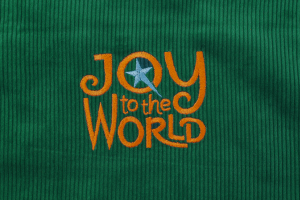Machine Embroidery on Corduroy – Everything You Should Know
Machine Embroidery on Corduroy – Everything You Should KnowOne thing that we love about embroidery is how it’s constantly evolving. Every d ..
Machine Embroidery on Corduroy – Everything You Should Know
One thing that we love about embroidery is how it’s constantly evolving. Every day we hear of some new technique trending in the embroidery world that we get excited to try. One such technique is the use of corduroy in machine embroidery. But what is corduroy, and how can you use it to create amazing embroidery pieces? This article discusses everything you need to know about doing machine embroidery on corduroy.
What is Corduroy?
People in the stitching and textile world know that corduroy is a type of fabric. Therefore, these people are aware of the look and texture of corduroy. But are you an embroidery noob who has never come across corduroy? Let us discuss some distinctive features of this fabric. Well, to start it off, corduroy has a texture with raised cords or wales. This happens because corduroy is made from three different yarns woven together. The two primary yarns take the form of a plain weave. The third yarn mixes into this and makes the distinctive raised cord. Therefore, you can see clear lines on a corduroy.
How do Embroiderers Feel About Corduroy?
Even though using corduroy as a base fabric for different embroidery designs is a unique trend, there has been a debate on it in the embroidery world. Some people prefer using corduroy, while others avoid it for its distinct texture.
Fortunately, we’re in the latter group, and we love doing embroidery on corduroy. Embroidery on corduroy might take a lot of effort and time, but the result, the rich shade of different colors on a corduroy cloth, is so worth the effort.
Why is Embroidery on Corduroy Challenging?
One of the reasons so many embroiderers are hesitant to do embroidery on corduroy is that it’s more challenging than doing embroidery on regular cotton, linen, jersey, or other fabric types. As mentioned above, corduroy has different risen textures on a fabric piece, which is why people can get confused about how to stitch. Moreover, stitches can also get lost in these raised cords and wales. But if the stitches get lost, how can we do embroidery on corduroy? Don’t worry; we have an excellent technique hidden in our sleeves.
At this point, you know that corduroy has risen wales, but this doesn’t mean that every piece of corduroy you purchase will have the same texture, pattern, size, and the number of wales. In fact, people who use corduroy usually differentiate it based on the wales. The first category of corduroy many embroiderers prefer purchasing is the wide wale corduroy. As the name suggests, the wales (also called hills and valleys) on the fabric are thick and wide. Therefore, these wide wale corduroys are commonly used in men’s clothing and upholstery, especially their trousers.
On the other hand, fine wale corduroy has thin hills and valleys. Therefore, textile manufacturers make it for women’s apparel. Since the hills and valleys are thin in fine wale corduroy, the stitches don’t easily get lost in the fabric. However, the same doesn’t apply to wide wale corduroy. The thick and prominent wales provide a lot of room for stitches to disappear, making it highly challenging for embroiderers to do embroidery on it.
However, wales aren’t the only thing embroiderers consider when selecting a corduroy. They also consider the stretch of the corduroy, which makes embroidery even more challenging. This usually happens because corduroy is slightly stretchable, making it difficult for embroiderers to add the fabric to a hoop. Stretchable fabrics can get over-stretched during hooping and other embroidery steps, resulting in a distorted embroidery design once the fabric returns to its original shape after being removed from the embroidery hoop.
Some Reasons You Might Want to Get Corduroy
Despite repeatedly mentioning that doing embroidery on corduroy is challenging, even for embroidery nerds, should you think you should do embroidery on corduroy? What makes corduroy so great that people rush to do embroidery on corduroy, despite it being challenging? Well, luckily, we have the answers! Corduroy is a highly-durable fabric that lasts for a long time. Therefore, if you want to make durable, long-lasting clothes, we recommend trying corduroy.
In addition, corduroy is available in multiple bright colors. This makes corduroy the perfect option for children’s clothing and even for adult funky and boho clothes. Some people even use corduroy to create tote bags due to corduroy’s bright colors and durability. Another surprising factor about corduroy is that many people even use it in corduroy. It’s durable, which makes it the perfect option for cushion covers, pillowcases, etc. And, of course, once you have stitched a pillow case or cushion cover from corduroy, you have to add a cute embroidery design to it.
Step-By-Step Guide to Doing Embroidery on Corduroy
Now that you know everything about corduroy, from its challenges to the benefits, it’s time to get down to business. In this article, we will discuss how to do embroidery on an old corduroy cloth and give it a whole new look. So, what are you waiting for? Scroll down, read and begin!
What Do You Need?
However, you need some things before you start machine embroidery on corduroy. Here’s a list.
● A good quality embroidery machine.
● An embroidery hoop to hold the fabric
● A water-based removable stabilizer
● An appliqué design
● Old skirt, shirt, or trousers made or corduroy you would like to revampPrepare the Fabric
The first step of doing machine embroidery on corduroy is to hoop the fabric. Ensure that you aren’t stretching the material, or your final design will be distorted. However, don’t leave the fabric as it is, or you will end with a jumbled embroidery design. Instead, smooth out the fabric using a light hand. Hoop the fabric in the embroidery hoop and ensure, again, that it isn’t stretched to maximum capacity.
Hoop the Stabilizer
Once your corduroy is fit in the embroidery hoop, it’s time to add the stabilizer. A stabilizer on the back of the corduroy will prevent the stitches of the embroidery design from sinking inside the fabric. You can use a medium or light-weight stabilizer for a fine wale corduroy, while a heavy-weight corduroy is better for a wide wale corduroy.
Pick an Appliqué Design
You might be tempted to add cute, little appliqué designs to your appliqué, but is that a wise choice? While delicate designs look amazing on your chest or the trouser pocket, they have higher chances of getting lost in the ups and downs of the corduroy fabric. On the other hand, if you select a solid, filled appliqué design, it has a lower possibility of getting lost in the corduroy’s channel. Go for something round or huge and make your embroidery funky and noticeable instead of fine!
Stitch the Appliqué Design
Now comes the final step; place the hoop with the corduroy fabric inside, and stitch the appliqué design. Lo and behold, you have your own new, trendy, corduroy shirt, skirt, or trouser in front of you. Wear it, go out, and see heads turn!
Steps for doing machine embroidery on corduroy
• Since hooping can leave marks on corduroy you need to float it Us adhesive backed stabilizer.
• Stick cutaway backing on back of fabric where you need to embroider
• Adhere the corduroy along with cutaway to adhesive backed stabilizer.
• Add layer of WSS on top of corduroy
• Start embroidering and remove WSS (water-soluble stabilizer) after you are doneConclusion
While doing embroidery on corduroy is challenging, it’s also rewarding. To some extent, the challenging part makes it more exciting, but it’s the final result that we love. Doing embroidery on corduroy has the power to transform an old clothing item in your wardrobe into a modern piece you can wear anywhere. In the start, you might have some problems getting the stitches right or preventing them from getting lost in corduroy, but trust us, you’ll get the hang of it and will love doing embroidery on corduroy.
We hope this step-by-step guide to doing embroidery on corduroy was useful, and you’ll put this information to good use and create many funky embroidery designs on your corduroy clothes. It’s time to bring out old corduroy pieces from the back of your wardrobe and start embroidering. Good luck!

